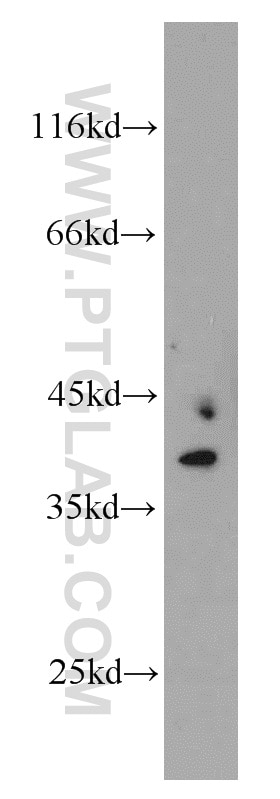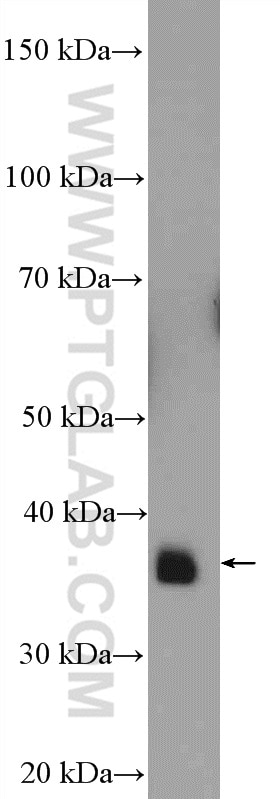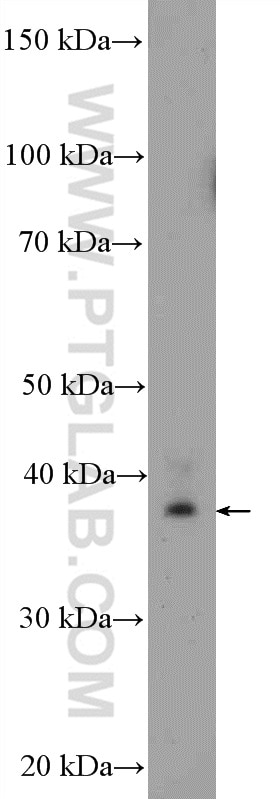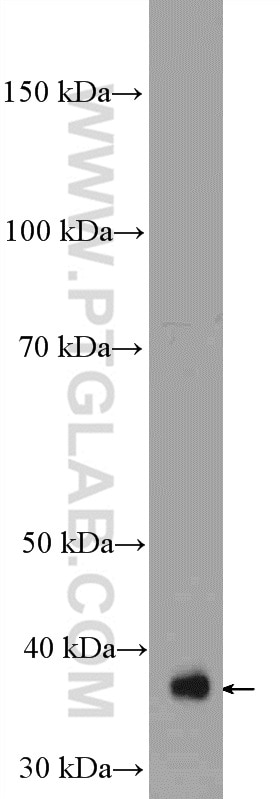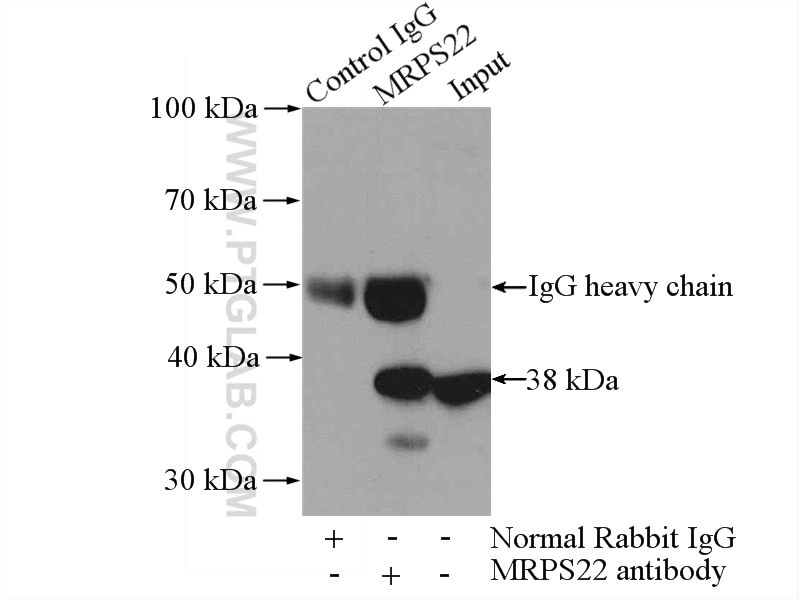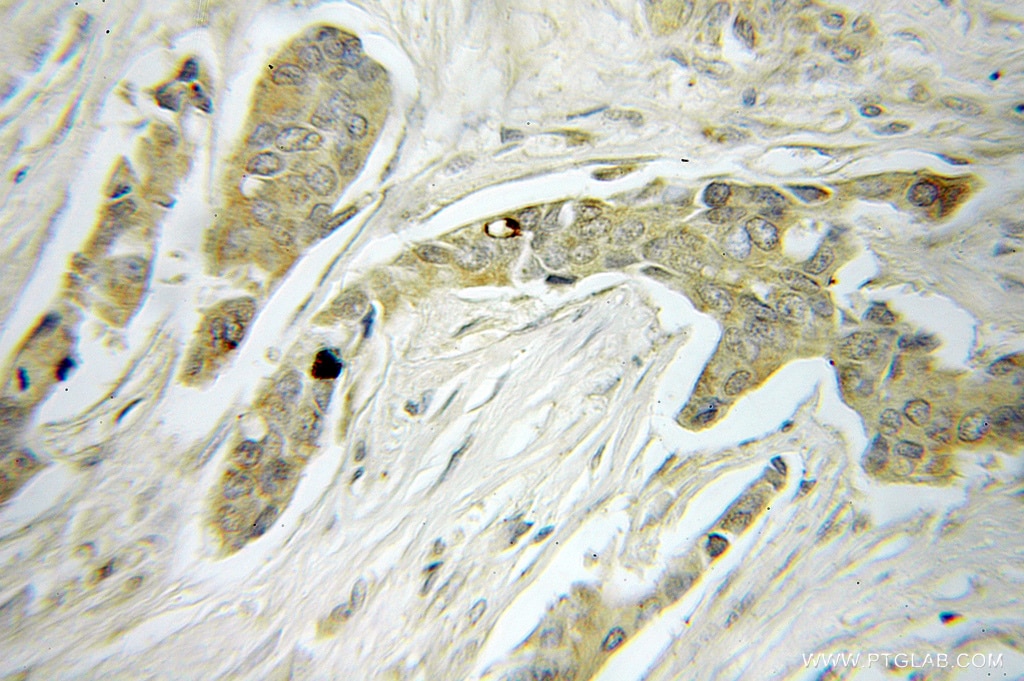Anticorps Polyclonal de lapin anti-MRPS22
MRPS22 Polyclonal Antibody for WB, IP, IHC, ELISA
Hôte / Isotype
Lapin / IgG
Réactivité testée
Humain, rat, souris
Applications
WB, IHC, IP, ELISA
Conjugaison
Non conjugué
N° de cat : 10984-1-AP
Synonymes
Galerie de données de validation
Applications testées
| Résultats positifs en WB | cellules Jurkat, tissu hépatique de souris, tissu splénique de rat, tissu splénique de souris |
| Résultats positifs en IP | cellules Jurkat |
| Résultats positifs en IHC | tissu de cancer du sein humain il est suggéré de démasquer l'antigène avec un tampon de TE buffer pH 9.0; (*) À défaut, 'le démasquage de l'antigène peut être 'effectué avec un tampon citrate pH 6,0. |
Dilution recommandée
| Application | Dilution |
|---|---|
| Western Blot (WB) | WB : 1:200-1:1000 |
| Immunoprécipitation (IP) | IP : 0.5-4.0 ug for 1.0-3.0 mg of total protein lysate |
| Immunohistochimie (IHC) | IHC : 1:20-1:200 |
| It is recommended that this reagent should be titrated in each testing system to obtain optimal results. | |
| Sample-dependent, check data in validation data gallery | |
Applications publiées
| WB | See 23 publications below |
Informations sur le produit
10984-1-AP cible MRPS22 dans les applications de WB, IHC, IP, ELISA et montre une réactivité avec des échantillons Humain, rat, souris
| Réactivité | Humain, rat, souris |
| Réactivité citée | Humain, souris |
| Hôte / Isotype | Lapin / IgG |
| Clonalité | Polyclonal |
| Type | Anticorps |
| Immunogène | MRPS22 Protéine recombinante Ag1421 |
| Nom complet | mitochondrial ribosomal protein S22 |
| Masse moléculaire calculée | 41 kDa |
| Poids moléculaire observé | 38 kDa |
| Numéro d’acquisition GenBank | BC009296 |
| Symbole du gène | MRPS22 |
| Identification du gène (NCBI) | 56945 |
| Conjugaison | Non conjugué |
| Forme | Liquide |
| Méthode de purification | Purification par affinité contre l'antigène |
| Tampon de stockage | PBS with 0.02% sodium azide and 50% glycerol |
| Conditions de stockage | Stocker à -20°C. Stable pendant un an après l'expédition. L'aliquotage n'est pas nécessaire pour le stockage à -20oC Les 20ul contiennent 0,1% de BSA. |
Informations générales
MRPS22, also named as C3orf5, RPMS22 and S22mt, is a component of the mitochondrial ribosome small subunit (28S) which comprises a 12S rRNA and about 30 distinct proteins. Defects in MRPS22 are the cause of combined oxidative phosphorylation deficiency type 5 (COXPD5). MRPS22 is a 360-amino-acid protein that has been found in a limited number of species, having no ortholog in fungi or prokaryotes. The exact location of MRPS22 in the three dimensional structure of the ribosome and its exact function are currently unknown. Recently, a MRPS22 defect was shown to strongly hamper assembly of the small ribosomal subunit, whereas assembly of the large subunit and part of the small subunit were only mildly affected.(PMID:21189481)
Protocole
| Product Specific Protocols | |
|---|---|
| WB protocol for MRPS22 antibody 10984-1-AP | Download protocol |
| IHC protocol for MRPS22 antibody 10984-1-AP | Download protocol |
| IP protocol for MRPS22 antibody 10984-1-AP | Download protocol |
| Standard Protocols | |
|---|---|
| Click here to view our Standard Protocols |
Publications
| Species | Application | Title |
|---|---|---|
Cell Metab The mitochondrial RNA-binding protein GRSF1 localizes to RNA granules and is required for posttranscriptional mitochondrial gene expression. | ||
Cell Rep The Human Mitochondrial DEAD-Box Protein DDX28 Resides in RNA Granules and Functions in Mitoribosome Assembly. | ||
PLoS Genet Mutations in the UQCC1-Interacting Protein, UQCC2, Cause Human Complex III Deficiency Associated with Perturbed Cytochrome b Protein Expression. | ||
Nucleic Acids Res C7orf30 specifically associates with the large subunit of the mitochondrial ribosome and is involved in translation. | ||
Nucleic Acids Res p32/gC1qR is indispensable for fetal development and mitochondrial translation: importance of its RNA-binding ability. | ||
